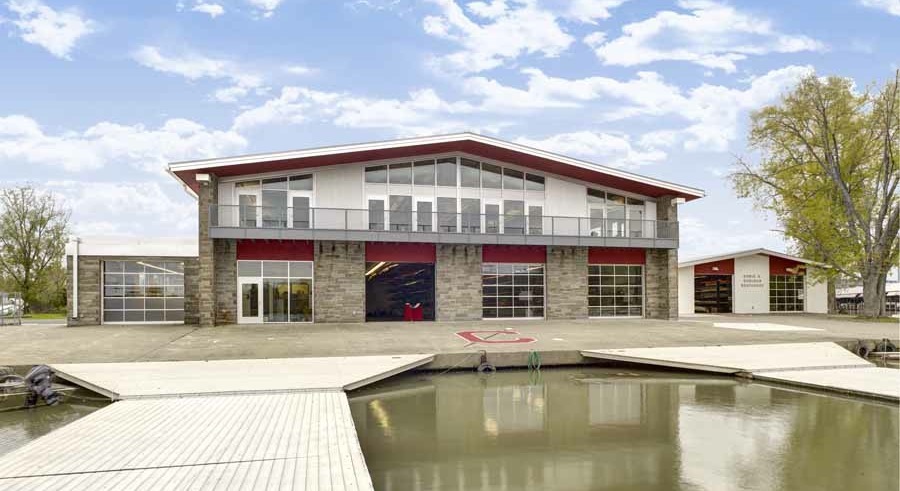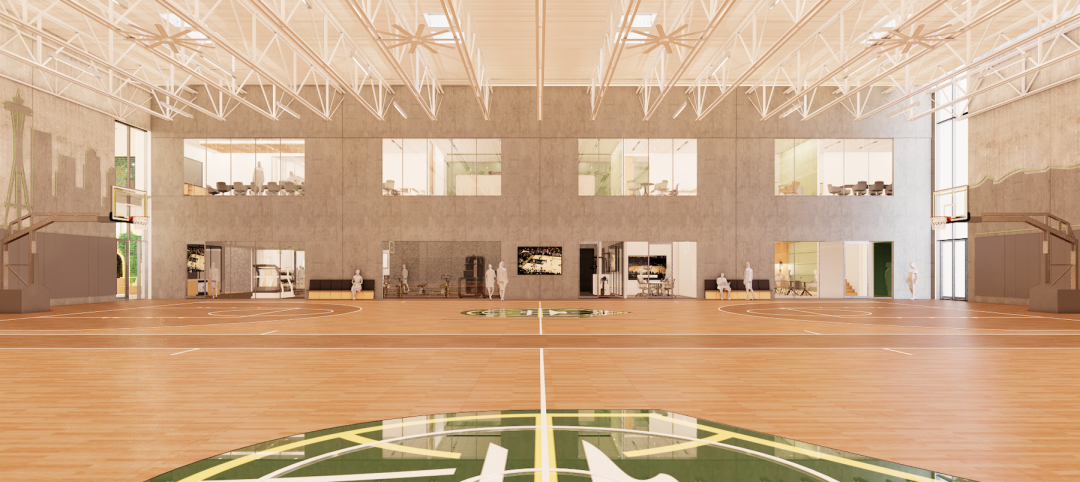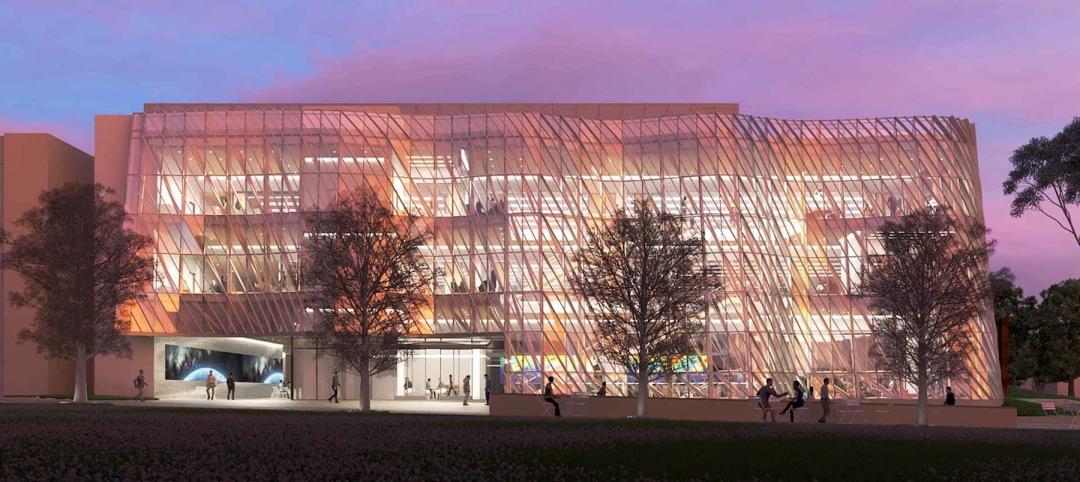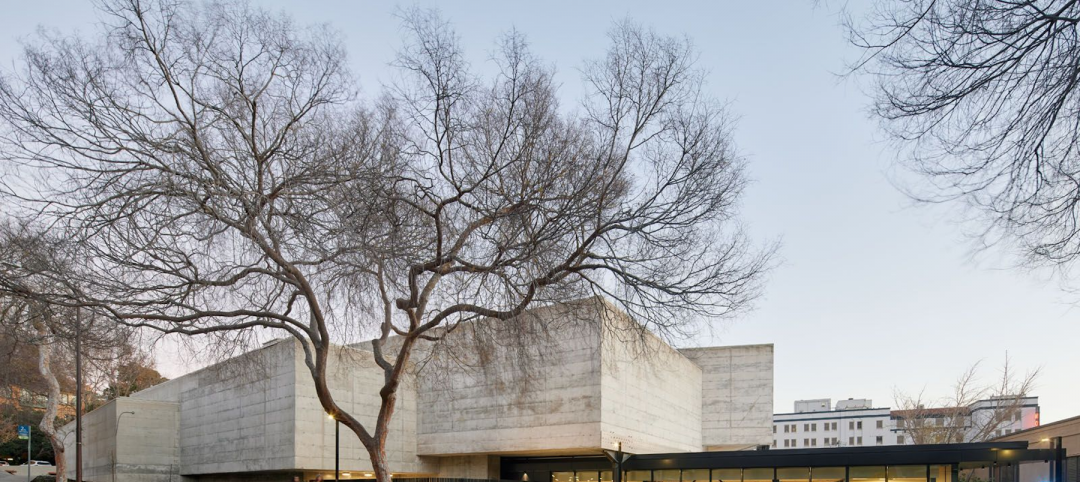The Cornell University Rowing teams have been on a winning streak recently. Since 2006, the men’s lightweight crew has won threeIRA (Intercollegiate Rowing Association) national championship crowns while the men’s heavyweight and women’s teams have medaled at national regattas and continued to improve their competitive standing.
Now the teams have an expanded Rowing Center to match their athletic gains.
Designed by HGA Architects and Engineers (HGA), Cornell’s updated Rowing Center overlooking Lake Cayuga in Ithaca, N.Y, repositions two existing boathouses into an advanced training facility that competes with the best in the nation.
Cornell’s crews include approximately 150 athletes on three teams—Men’s Heavyweight, Men’s Lightweight, and Women’s. The rowing facility had consisted of the two-story, 15,000-square-foot Collyer Boathouse built in 1957 for the men’s teams, and the adjacent one-story, 5,000-square-foot Robison Boathouse built in 1979 for the women’s team.
While serving their purpose well over the years, the boathouses lacked the infrastructure to fully support the growing teams—especially compared to newer facilities by competitors. The women’s crew, for instance, had tripled since it became a varsity team in the 1970s, yet the locker rooms were one-third the size of the men’s. In addition, neither building had adequate boat storage or indoor training equipment, with the crews splitting training between the Cayuga Inlet and Teagle Hall Fitness Center.
Cornell conducted an earlier study that recommended razing the boathouses for a new facility. However, when funding sources weren't adequate for this plan, the college cut back and looked for other options. Working with HGA, Cornell was able to arrive at a solution that fit the needs of the school, the athletic department, and the crews.
The 31,360-square-foot renovation consists of a two-story addition housing separate locker rooms for the three teams, shower rooms, laundry facility, a Tradition Room displaying crew memorabilia, and meeting spaces. It is connected to the Collyer Boathouse via a two-story entrance lobby with a second-floor bridge. An outdoor gathering space connects to the lobby.
Collyer’s second-floor has been converted to a multi-purpose training room with state-of-the-art exercise equipment and weightlifting stations. The first level houses boat storage, waterfront offices for coaches, a water safety room, and repair bay.
Robison Boathouse, meanwhile, was cleared of its outdated locker room and offices and now functions solely as rowing shell and equipment storage. Doors were added to the backside of both original buildings to allow the teams to load shell trailers for event travel from the parking lot. The new door at Collyer even allows the teams to pull a loaded trailer into the boat bay in December to streamline departures for winter training. A new launch storage building completes the set of three structures.
Throughout Collyer and the addition, large windows overlook the water and oversized graphics and bold red accents emphasize Big Red traditions. The locker rooms include off-the-shelf resin lockers customized with integral venting and on-demand heating to allow the staff to dry damp rowing gear overnight and exhaust odors fully within the locker.
Exterior upgrades work within the existing buildings’ style and massing. HGA replaced wooden doors with glass doors to open the interior to views of the water, replaced and reconfigured upper windows, repaired stonework, and added metal standing-seam roofs over the three structures to architecturally unify them and provide durable performance over the long term. The crisp existing color palette of nautical white paint, local bluestone accent panels and Cornell Red trim was restored and extended to the addition.
The site itself presented structural challenges due to the soft load-bearing soil conditions. With marginal soil-bearing capacity and bedrock far below affordable levels to reach with piers, HGA's team designed a system that pre-loaded the site to force settlement before pouring a three-foot-thick concrete-slab mat foundation for the addition. New structural framing for the addition cantilevers toward Collyer without actually bearing on the existing structure.
And while Collyer was structurally sound, HGA reinforced the joists on the second level to support increased capacity for the weight-lifting stations.
The project provides significant savings for the Athletic Department through a number of sustainable features, including an upgraded exterior envelope with added insulation and thermal-pane windows, energy-efficient fixtures, room occupancy sensors, lighting control systems, and an air-to-air heat exchanger to temper the high fresh air loads. In addition, the tight site integrates native plantings and pervious pavement to treat surface storm water and creates a right-of-way for the Cayuga Waterfront Trail, a public bike/pedestrian path.
Since its dedication this summer, the Rowing Center has proved a winner on all counts. The Athletic Department has a cost-efficient facility that provides effective training and team support, adds much-needed boat storage, upholds the University’s gender equity standards, preserves the heritage of the existing structures, and provides an outstanding environment for recruiting and alumni events.
HGA directed architecture, interior, structural, mechanical and electrical services. HGA’s project team included d’Andre Willis, AIA, principal and project manager; Loren Ahles, FAIA, project lead designer; Kendra Beaubien, AIA, project architect; Kevin Allebach, RA, project architect; Amy Tasch, LEED AP, interior designer; Sarah Jorczak, PE, structural engineer; Lance Kempf, PE, mechanical engineer; and Ben Gutierrez, electrical. The team also included Welliver McGuire, Inc., general contractor; CHA, civil engineer; and CHA, landscape architect. BD+C
Related Stories
Sports and Recreational Facilities | May 26, 2022
WNBA practice facility will offer training opportunities for female athletes and youth
The Seattle Storm’s Center for Basketball Performance will feature amenities for community youth, including basketball courts, a nutrition center, and strength and conditioning training spaces.
Multifamily Housing | May 25, 2022
9 noteworthy multifamily developments to debut in 2022
A 1980s-era shopping mall turned mixed-use housing and a mid-rise multifamily tower with unusual rowhomes highlight the innovative multifamily developments to debut recently.
Coronavirus | May 20, 2022
Center for Green Schools says U.S. schools need more support to fight COVID-19
The Center for Green Schools at the U.S. Green Building Council released a new report detailing how school districts around the country have managed air quality within their buildings during the second year of the COVID-19 pandemic.
Regulations | May 20, 2022
Biden’s Clean Air in Buildings Challenge aims to reduce COVID-19 spread
The Biden Administration recently launched the Clean Air in Buildings Challenge that calls on all building owners and operators, schools, colleges and universities, and organizations to adopt strategies to improve indoor air quality in their buildings and reduce the spread of COVID-19.
Building Team | May 20, 2022
Caltech breaks ground on a new center to study climate and sustainability
The California Institute of Technology (Caltech) recently broke ground on its Resnick Sustainability Resource Center.
Laboratories | May 20, 2022
Brutalist former Berkeley Art Museum transformed into modern life science lab
After extensive renovation and an addition, the former Berkeley Art Museum and Pacific Film Archive at the University of California, Berkeley campus reopened in May 2022 as a modern life science lab building.
Sports and Recreational Facilities | May 19, 2022
Northern Arizona University opens a new training center for its student athletes
In Flagstaff, Ariz. Northern Arizona University (NAU) has opened its new Student-Athlete High Performance Center.
Energy-Efficient Design | May 19, 2022
Shipping containers used to build Research Triangle Park’s first community gathering space
Shipping containers were the prominent building material used to construct Boxyard RTP, the first public community and gathering place in North Carolina’s Research Triangle Park (RTP).
Mixed-Use | May 19, 2022
Seattle-area project will turn mall into residential neighborhood
A recently unveiled plan will transform a 463,000 sf mall into a mixed-use destination site in the Seattle suburb of Bellevue, Wash.
Architects | May 19, 2022
The art and trade of architectural photography, with Brad Feinknopf
Longtime architectural photographer Brad Feinknopf discusses his craft and helping AEC firms realize their visions photographically. Feinknopf also touches on the evolution of photo shoots and the role of technology in architectural photography.

















